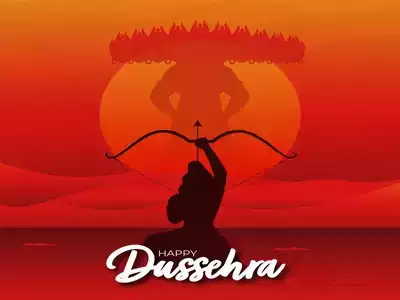Blog Credit: Trupti Thakur
Image Courtesy: Google
Vijaya Dashmi
Vijaydashami History and Significance:
Dussehra, also known as ‘Vijayadashami,’ holds a special place in the hearts of Indians as one of the most significant festivals. It signifies the conclusion of the nine-day extravaganza of Navratri and the four or five-day celebration of Durga Puja.
This auspicious day is steeped in mythological significance, as it is believed to mark the triumphant moment when Lord Rama vanquished the demon King Ravana and his malevolent army after a protracted battle between the forces of righteousness and evil. This monumental victory has led to the day being christened as Vijay Dashami, the Day of Victory.
Furthermore, Dussehra also symbolises the day when the fierce Goddess Durga confronted and annihilated Mahishasura’s formidable army, ultimately slaying the buffalo demon. The festival, celebrated with great fervour across India, carries with it the profound message of the conquest of good over evil.
Why we Celebrate Vijaydashami?
This year, Dussehra falls on October 24, and according to Drik Panchang, the auspicious Puja time will be encompassed within the Dashami Tithi. The Tithi commences on October 23 at 5:45 pm and concludes on October 24 at 3:14 pm.
It’s worth noting that even though Dashami and Dussehra entail distinct rituals, they share the common theme of celebrating the victory of good over evil.
Dussehra, also called ‘Vijayadashami,’ holds an extraordinary spot in the hearts of Indians as perhaps the most important celebration. It marks the end of the nine-day event of Navratri and the four or five-day festivity of Durga Puja.This divine day holds immense mythological significance, as it is said to mark the victorious moment when Lord Rama destroyed the devil Lord Ravana and his evil army post an extended fight between the powers of righteousness and evil. This great triumph has since then been celebrated as Vijay Dashami, the Day of Triumph.
Moreover, Dussehra represents the day when the Goddess Durga went up against and demolished Mahishasura’s powerful army, eventually killing the buffalo demon. The festivity celebrated with extraordinary fervour across India, carries with it the significant message of the success of good over evil.
This year, Dussehra lies on October 24, and as indicated by Drik Panchang, the promising Puja time will be incorporated within the Dashami Tithi. The Tithi starts on October 23 at 5:45 pm and closes on October 24 at 3:14 pm.
Despite the fact that Dashami and Dussehra involve distinct customs, they share the common subject of praising the triumph of good over evil.
On this day, the streets come alive with vibrant Ramlila performances, particularly in the northern areas of the country. These establishments vividly portray the life and bravery of the honest Lord Rama through ballads and plays.
Vijayadashami 2023: Importance
Dussehra marks the beginning of the Diwali festivities. It falls twenty days before the celebrations of light observing Lord Rama, Maa Sita and Lord Lakshman’s homecoming. The celebration of Vijayadashami teaches the ethos of the triumph of good over evil and light over darkness.
On this day, the believers of Hindu faith worship God for success and great health. Moreover, loving the Shami tree on the day of Vijayadashami holds extraordinary importance in certain parts of the nation, as it is believed that Arjun hid his weapons inside the Shami tree during his exile.
Vijayadashami: Rituals
Shami Puja – Prayer of the Shami tree represents the triumph of the Pandavas in the Mahabharata.
Aparajita Puja – Dedication to the goddess Aparajita implies the undefeated soul of good.
Seema Avalanghan – Crossing the line, an exercise that exemplifies growing one’s viewpoints and overcoming restrictions.
Shastra Puja or Ayudha Puja – On Vijayadashami, goddess Durga conquered a devil. Following her triumph, the gods worshipped her weapons. Devotees on this day worship their own weapons and tools, offering them to the goddess as a token of gesture and appreciation.
Dussehra 2023: Celebrations
In North India and different parts of the nation, Dussehra or Vijayadashami is celebrated by burning effigies of Ravana, brother, Kumbhkaran, and the fearless son of Ravana, Meghnad.
Ramlila, an act of Rama’s story, is coordinated on every nine days of Navratri. It finishes with the killing of Ravana on the 10th day. Dussehra likewise implies disposing of sins or bad characteristics, as the ten heads of Ravana represent one bad quality.
In Bengal, devotees submerge the Maa Durga idols in water bodies and bid her a great adieu. They additionally wish the Goddess to come next year and watch out for them while warding off every one of the evils and miseries.
Blog By: Trupti Thakur

24
OctVijaya Dashmi 2023
Oct 24, 2023Recent Blog
The V2G TechnologyApr 21, 2025
Country’s Specific Domain By GoogleApr 19, 2025
The ITES-QApr 17, 2025
The UPI Circle Of PhonePeApr 16, 2025
Dangerous AI In HealthcareApr 15, 2025




